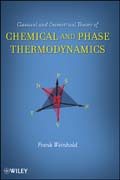
Classical and geometrical theory of chemical and phase thermodynamics
Weinhold, Frank
Because it is grounded in math, chemical thermodynamics is often perceived asa difficult subject and many students are never fully comfortable with it. The first authoritative textbook presentation of equilibrium chemical and phase thermodynamics in a reformulated geometrical framework, Chemical and Phase Thermodynamics shows how this famously difficult subject can be accurately expressed with only elementary high-school geometry concepts. Featuring numerous suggestions for research-level extensions, this simplified alternative to standard calculus-based thermodynamics expositions is perfect for undergraduate and beginning graduate students as well as researchers. INDICE: PREFACE. PART I INDUCTIVE FOUNDATIONS OF CLASSICAL THERMODYNAMICS.1. Mathematical Preliminaries: Functions and Differentials. 1.1 Physical Conception of Mathematical Functions and Differentials. 1.2 Four Useful Identities. 1.3 Exact and Inexact Differentials. 1.4 Taylor Series. 2. Thermodynamic Description of Simple Fluids. 2.1 The Logic of Thermodynamics. 2.2 Mechanical andThermal Properties of Gases: Equations of State. 2.3 Thermometry and the Temperature Concept. 2.4 Real and Ideal Gases. 2.5 Condensation and the GasLiquid Critical Point. 2.6 Van der Waals Model of Condensation and Critical Behavior.2.7 The Principle of Corresponding States. 2.8 Newtonian Dynamics in the Absence of Frictional Forces. 2.9 Mechanical Energy and the Conservation Principle. 2.10 Fundamental Definitions: System, Property, Macroscopic, State. 2.11 TheNature of the Equilibrium Limit. 3. General Energy Concept and the First Law.3.1 Historical Background of the First Law. 3.2 Reversible and Irreversible Work. 3.3 General Forms of Work. 3.4 Characterization and Measurement of Heat. 3.5 General Statements of the First Law. 3.6 Thermochemical Consequences of the First Law. 4. Engine Efficiency, Entropy, and the Second Law. 4.1 Introduction: Heat Flow, Spontaneity, and Irreversibility. 4.2 Heat Engines: Conversion of Heat to Work. 4.3 Carnots Analysis of Optimal Heat-Engine Efficiency. 4.4 Theoretical Limits on Perpetual Motion: Kelvins and Clausius Principles. 4.5 Kelvins Temperature Scale. 4.6 Carnots Theorem and the Entropy of Clausius. 4.7 Clausius Formulation of the Second Law. 4.8 Summary of the Inductive Basis of Thermodynamics. PART II GIBBSIAN THERMODYNAMICS OF CHEMICAL AND PHASE EQUILIBRIA. 5. Analytical Criteria for Thermodynamic Equilibrium. 5.1 The Gibbs Perspective. 5.2 Analytical Formulation of the Gibbs Criterion for a System in Equilibrium. 5.3 Alternative Expressions of the Gibbs Criterion. 5.4 Duality of Fundamental Equations: Entropy Maximization versus Energy Minimization. 5.5 OtherThermodynamic Potentials: Gibbs and Helmholtz Free Energy. 5.6 Maxwell Relations. 5.7 Gibbs Free Energy Changes in Laboratory Conditions. 5.8 Post-GibbsianDevelopments. 6. Thermodynamics of Homogeneous Chemical Mixtures. 6.1 Chemical Potential in Multicomponent Systems. 6.2 Partial Molar Quantities. 6.3 The GibbsDuhem Equation. 6.4 Physical Nature of Chemical Potential in Ideal and Real Gas Mixtures. 7. Thermodynamics of Phase Equilibria. 7.1 The Gibbs Phase Rule. 7.2 Single-Component Systems. 7.3 Binary Fluid Systems. 7.4 Binary SolidLiquid Equilibria. 7.5 Ternary and Higher Systems. 8. Thermodynamics of Chemical Reaction Equilibria. 8.1 Analytical Formulation of Chemical Reactions in Termsof the Advancement Coordinate. 8.2 Criterion of Chemical Equilibrium: The Equilibrium Constant. 8.3 General Free Energy Changes: de Donders Affinity. 8.4 Standard Free Energy of Formation. 8.5 Temperature and Pressure Dependence of the Equilibrium Constant. 8.6 Le Chateliers Principle. 8.7 Thermodynamics of Electrochemical Cells. 8.8 Ion Activities in Electrolyte Solutions. 8.9 Concluding Synopsis of Gibbs Theory. PART III METRIC GEOMETRY OF EQUILIBRIUM THERMODYNAMICS. 9. Introduction to Vector Geometry and Metric Spaces. 9.1 Vector and Matrix Algebra. 9.2 Dirac Notation. 9.3 Metric Spaces. 10. Metric Geometry of Thermodynamic Responses. 10.1 The Space of Thermodynamic Response Vectors. 10.2 The Metric of Thermodynamic Response Space. 10.3 Linear Dependence, Dimensionality, and GibbsDuhem Equations. 11. Geometrical Representation of Equilibrium Thermodynamics. 11.1 Thermodynamic Vectors and Geometry. 11.2 Conjugate Variables and Conjugate Vectors. 11.3 Metric of a Homogeneous Fluid. 11.4 General Transformation Theory in Thermodynamic Metric Space. 11.5 Saturation Properties Along the Vapor-Pressure Curve. 11.6 Self-Conjugate and Normal Response Modes.11.7 Geometrical Characterization of Common Fluids. 11.8 Stability Conditionsand the Third Law for Homogeneous Phases. 11.9 The Critical Instability Limit. 11.10 Critical Divergence and Exponents. 11.11 Phase Heterogeneity and Criticality. 12. Geometrical Evaluation of Thermodynamic Derivatives. 12.1 Thermodynamic Vectors and Derivatives. 12.2 General Solution for Two Degrees of Freedom and Relationship to Jacobian Methods. 12.3 General Partial Derivatives in Higher-Dimensional Systems. 12.4 Phase-Boundary Derivatives in Multicomponent Systems. 12.5 Stationary Points of Phase Diagrams: GibbsKonowalow Laws. 12.6 Higher-Order Derivatives and State Changes. 13. Further Aspects of Thermodynamic Geometry. 13.1 Reversible Changes of State: Riemannian Geometry. 13.2 Near-Equilibrium Irreversible Thermodynamics: Diffusional Geometry. 13.3 Quantum Statistical Thermodynamic Origins of Chemical and Phase Thermodynamics. Appendix: Units and Conversion Factors. AUTHOR INDEX. SUBJECT INDEX.
- ISBN: 978-0-470-40236-8
- Editorial: John Wiley & Sons
- Encuadernacion: Cartoné
- Páginas: 490
- Fecha Publicación: 23/02/2009
- Nº Volúmenes: 1
- Idioma: Inglés
